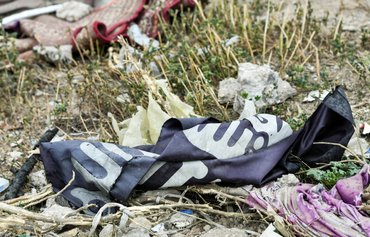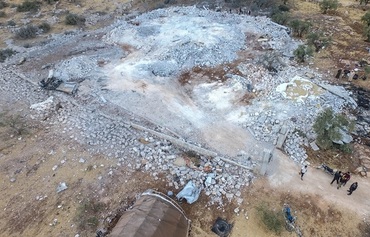The death of the second leader of the "Islamic State of Iraq and Syria" (ISIS) in under a year shows the once powerful extremist group has lost its ability to operate a global network from Syria, analysts said.
But the group, which ruled over swathes of Syria and Iraq before being defeated there, still has active branches in other parts of the world, including West Africa and Afghanistan, they warned.
Many questions remain unanswered around the death of Abu Hasan al-Hashimi al-Qurashi, announced November 30 in an audio message and later confirmed by US Central Command (CENTCOM).
Local sources said the top ISIS leader had blown himself up under siege -- following in the footsteps of his short-lived predecessors -- as Syrian opposition factions carried out an operation in mid-October.
![Personal objects are scattered on the roof of the house in which former ISIS leader Abu Ibrahim al-Hashimi al-Qurashi died, during an overnight raid by US special forces, in the town of Atme in Syria's northwestern province of Idlib, on February 3. [Muhammad Haj Kadour/AFP]](/cnmi_am/images/2022/12/05/39298-qurashi-600_384.jpg)
Personal objects are scattered on the roof of the house in which former ISIS leader Abu Ibrahim al-Hashimi al-Qurashi died, during an overnight raid by US special forces, in the town of Atme in Syria's northwestern province of Idlib, on February 3. [Muhammad Haj Kadour/AFP]
Al-Hashimi's seven months of clandestine rule were characterised by silence, leaving countless other questions on the direction in which ISIS may be headed.
"You could argue that he had the least impact of any ISIS leader since the group's inception," said Colin Clarke, director of research at intelligence and security think-tank Soufan Group.
More than a month had elapsed between al-Hashimi's death and the group's statement, during which "ISIS was likely scrambling internally to line up a replacement", the expert said.
This may indicate "the group is under extreme pressure from multiple adversaries and has less freedom of manoeuvre than in the past, including in a more restricted ability to communicate with supporters and followers", he said.
None of the experts contacted by AFP could provide any information concerning the new leader, Abu al-Hussein al-Husseini al-Qurashi, whose nom de guerre carries on a reference to the Prophet Mohammad's tribe.
The new self-proclaimed caliph seeks to draw legitimacy by claiming heritage from the prophet's Quraysh tribe -- as did all ISIS leaders before him.
"The al-Qurashi name is used as a branding for the leader," said Hans-Jakob Schindler, director of the Counter-Extremism Project think-tank.
"Even if it is just a made-up name ... it is sufficient for the network to function."
Egyptian researcher Mounir Adeeb told Asharq Al-Awsat that ISIS was withholding information, saying it was hard to determine the identity of the new leader because ISIS "has used a nickname, not his real name".
The group's "reticence in announcing the real identity of its new leader might raise ambiguity over the validity of the pledge of allegiance", the media outlet said, quoting "a well informed source".
The appointment could be a form of cover-up, the source said, "to hide the reality of the ongoing dispute within the organisation".
No more safe haven
After a meteoric rise in Iraq and Syria in 2014, ISIS saw its so-called caliphate collapse, reduced to a network of sleeper cells.
In 2019, it was defeated in Syria -- where al-Hashimi, Abu Ibrahim al-Qurashi and ISIS founder Abu Bakr al-Baghdadi were all killed.
"Syria is simply not a safe haven for ISIS anymore," said Schindler. "They can maintain a cell structure, but it is apparently not safe for high-ranking personnel there.
"If you are killing everyone, in the end no one is your ally anymore," he said.
Left without a sanctuary or charismatic leader, ISIS has lost the capacity it had under al-Baghdadi to recruit foreign fighters.
And al-Baghdadi's successors last for increasingly shorter periods, with the last two leaders perishing without having issued any audio or video statements.
"There is likely pressure building on ISIS ... to gain some momentum, particularly if the group wants to remain relevant," said Clarke of Soufan Group.
Still, the network affiliated with ISIS remains not only alive but deadly.
The ISIS-Khorasan outfit has some leverage over the regime in Afghanistan, and the group has maintained some capacity to cause harm in both Iraq and Syria.
But ISIS has seen its most striking rise recently across Africa, with a presence in the Sahel region, through to Lake Chad, all the way down to Mozambique and in Somalia.
Affiliates increase their power
Global extremism experts have noted in recent years that ISIS, like al-Qaeda, has moved to decentralise its operations and rely on local groups to take over territory during crises.
The deaths of yet another leader and his replacement are a testament to that.
"The vulnerability of the organisation's high command boosts the autonomy of its affiliates, particularly the most active ones in Afghanistan and the Sahel," said Jean-Pierre Filiu, an analyst teaching at the Sciences Po university in Paris.
But recent events raise questions over how long figures in the Middle East can claim leadership.
"It is a bit discriminatory that always an Arab guy from the Quraysh tribe will have to lead this network," Schindler said.
"Let's see how many more times the African parts of the network are going to accept this."
Throughout 2021, ISIS propaganda publication al-Naba dedicated 28 out of 52 front pages to African affiliates, according to a tally by Damien Ferre, founder of the Jihad Analytics group.
Indeed, seven out of ISIS's current 13 "provinces" are situated in Africa.
But for the time being, the Arab primacy remains uncontested.
"It would require Africans to go to the Iraq-Syria area and gradually impose themselves by rising in the hierarchy," argued researcher Djallil Lounnas of Morocco's Al Akhawayn University.
But "the weaker the central power gets, the more the African affiliates can increase their power".








